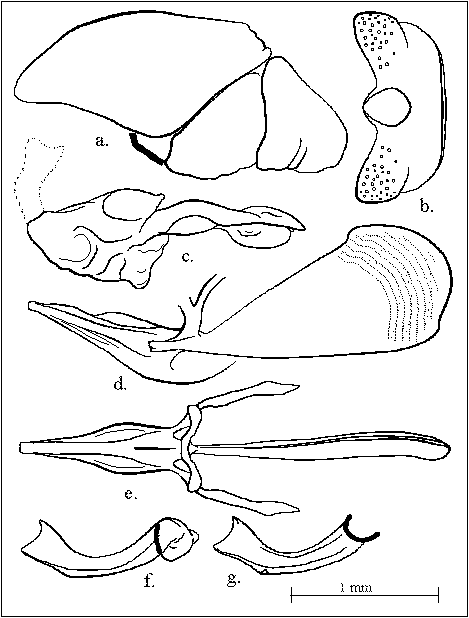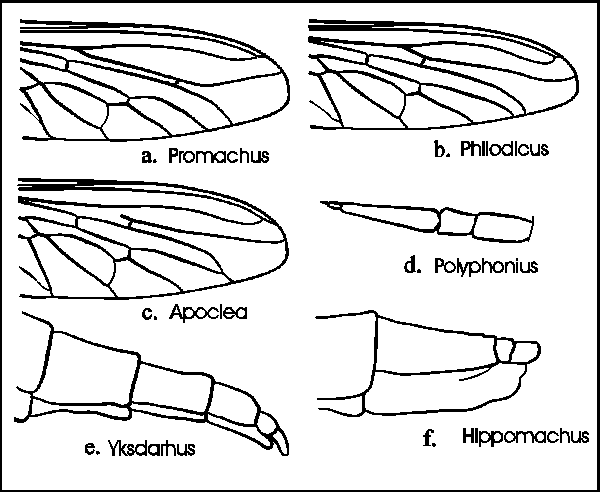|
[Eine neue Eremonotus-Art aus Marocko und einige Bemerkungen über die Unterfamilie Apocleinae in der Paläarktis (Diptera, Asilidae)]
by
[Published in: Studia Dipterologica 5(1): 61-66, Halle an der Saale]
Introduction
Study of Asilidae from North-Africa and Israel has established that specimens of Eremonotus from Morocco are different from the types of Eremonotus nudus Theodor, 1980, which Dr. Freidberg (Tel Aviv) placed at our disposal. E. nudus is recorded from Tunisia for the first time. Eremonotus is a member of the subfamily Apocleinae but there is no recent key, incorporating this genus. An illustrated key for the subfamily is therefore presented. Examination of the currently listed Palaearctic species of Neolophonotus has established that the genus is restricted to the Afrotropical region. All five species listed in the catalog of Palaearctic Diptera (Lehr, 1988) are either not species of Neolophonotus s.str. or their distribution is limited to the Afrotropical region.
Abbreviations:
Description
Eremonotus hauseri spec. nov. (Fig. 1a-g)
Material: Holotype: Morocco, Amesnaz, 30 km NNW Agadir, 30°38'N 9°47'W, 21.IV.1996, M. Schwarz leg., male; Paratypes: Morocco, High Atlas, 30 km S Tizi-n-Test, 30°31'N 8°24'W, 21.V.1995, M. Hauser leg., 2 males, 6 females; Marocco, Aoulouz, 09.V.1992, 30°41'N 8°10'W, Hradský leg., 6 males, 1 female. The holotype has been deposited in the collection of the Zoologische Staatssammlung München (ZSMC) and the paratypes in the collections of M. Hradský, M. Hauser and F. Geller-Grimm.
Holotype: Male. Length = 17 mm, Wings = 11 mm.
Key to the species of Eremonotus Theodor, 1980
Hair on ocellum and occipital bristles mainly white; bristels on mesonotum mainly black behind the transverse suture; fore and mid tibiae rarely with few black setae; short hair on legs whitish; costa in front of humeral crossvein with only yellow hair; short hair on the back of tergites mainly whitish; hair on sternites 7 and 8 more adpressed; male genitalia: apex of dististylus rounded, with only one dorsal point; apodeme shorter than the sheath (Fig. 831-838. In: Theodor, 1980) . . . . . . . . . . . . . . . . . . . . nudus Theodor, 1980 Hair on ocellum and occipital bristles mainly black and yellowish mixed; bristles on mesonotum mainly yellowish behind the transverse suture; fore and mid tibiae with black and yellow bristles mixed; short hair on legs yellowish; costa in front of humeral crossvein with yellow and black hair; short hair on the back of tergites mainly whitish; hair on sternites 7 and 8 erect; male genitalia (Fig. 1a-g): apex of dististylus concave, with two points; dististylus with a distinct spike on the ventral rim; apodeme 1,2 times longer than the sheath . . . . . . . . . . . . . . . . . . . . hauseri spec. nov.
Fig. 1a-g. Eremonotus hauseri spec. nov., male. - a. Hypopygium in lateral view; - b. Hypandrium in ventral view; - c. Basistylus in lateral view; - d. Aedeagus in lateral view; - e. Aedeagus in dorsal view; - f. Dististylus in lateral view (inner side); - g. Dististylus in lateral view (outer side).
First record of Eremonotus nudus Theodor, 1980 from North Africa
Eremonotus nudus Theodor, 1980 was described from Israel. It has now also been found in the mountains of Matmata (Tunisia, Matmata, 33°33'N 9°58'E, 7.IV.1995, 2 males, 1 female, F. Geller-Grimm leg.). It was recorded together with Amphisbetetus favillaceus (Loew in Rosenhauer, 1856), Antiphrisson trifarius (Loew, 1849), Dysmachus theodori Engel, 1930, Habropogon appendiculatus Schiner, 1867, Habropogon bipartitus Villeneuve, 1931, Heteropogon aureus Becker, 1907, Holopogon dichromatopus Bezzi, 1926 and two unidentified species of Saropogon. E. nudus flying over sandy pathes between the terraced fields. The Tunisian specimens differs only from the Israeli paratypes in the form of hair on the 8th sternite in males, which is denser and longer.
Key to the Palaearctic Apocleinae
The name Apocleina was used by Lehr (1969) for a small group of genera with similar characteristics. Papavero (1973) took up the name for the subfamily. Lehr (1988) listed the following Palaearctic genera: Alcimus Loew (not Palaearctic), Apoclea Macquart, Philodicus Loew and Promachus Loew. He places Eremonotus Theodor and Neolophonotus Engel under the subfamily Asilinae and did not consider Hippomachus Engel. Some parts of the following key are borrowed from Oldroyd (1963).
Wing with three submarginal cells (Fig. 2.a, b), the recurrent veinlet isn't always complete in Apoclea (Fig. 2.c) . . . . . . . . . . . . . . . . . . . . 2 Wing only with two submarginal cells . . . . . . . . . . . . . . . . . . . . 4 First posterior cell closed and stalked, or at least very strongly narrowed on wing margin; crossvein seperating second and third submarginal cells (Fig. 2.c) . . . . . . . . . . . . . . . . . . . . Apoclea Macquart, 1838 First posterior cell open, not strongly narrowed towards margin . . . . . . . . . . . . . . . . . . . . 3 Apparent cross-vein formed by base of the second submarginal cell situated beyond the apex of the distal cell (Fig. 2.a) . . . . . . . . . . . . . . . . . . . . Promachus - group Apparent cross-vein formed by base of the second submarginal cell situated before the apex of the discal cell (Fig. 2.b) . . . . . . . . . . . . . . . . . . . .
Philodicus - group Third antennal segment with only a short, wide, rather thin microsegment bearing an apical spine (Fig. 2.d); middle femur very greatly thickened and swollen, with much thickened spinose bristles . . . . . . . . . . . . . . . . . . . . Polyphonius Loew, 1848 Third antennal segment with a distinct style; middle femur not very greatly thickened and swollen . . . . . . . . . . . . . . . . . . . . 5 Mesonotum with well developed acrostichal and dorsocentral bristles (like a mane); wings of males dilated on costal margin . . . . . . . . . . . . . . . . . . . . 6 Mesonotum without an extraordinary mane of acrostichal and dorsocentral bristles; wings of males without dilation . . . . . . . . . . . . . . . . . . . . 7 Abdominal segments 6 - 9 shining in females, ovipositor long and narrow, cerci free (like Neoitamus, Fig. 2.e) . . . . . . . . . . . . . . . . . . . . Yksdarhus Hradský & Hüttinger, 1983 Abdominal segments 1 - 8 with tomentum in females; ovipositor shorter, cerci integrated into the ovipositor (like Dysmachus, Fig. 2.f) . . . . . . . . . . . . . . . . . . . . Hippomachus Engel, 1927 Ocelli distinctly visible; ovipositor dorsolateral compressed, without bands of spines at the end . . . . . . . . . . . . . . . . . . . . Eremonotus Theodor, 1980 Ocelli reduced to small spots; ovipositor cylindrical, with spines at the apex . . . . . . . . . . . . . . . . . . . . Apoclea Macquart, 1838
Fig. 2a-e. Palaearctic Apocleinae. - a. wing of Promachus; - b. wing of Philodicus; - c. wing of Apoclea; - d. antenna of Polyphonius; - e. ovipositor of Yksdarhus; - f. ovipositor of Hippomachus.
Remarks about Neolophonotus Engel, 1925 in Palaearctic region
Lehr (1988) includes 5 species of Neolophonotus in his Palaearctic catalog under the subfamily Asilinae. Londt (1985) unravels the confused history of this genus and clarifies the scope of the subfamily Apocleinae. The discussion in the following list shows, that all Neolophonotus species listed by Lehr (1988) are either not species of Neolophonotus s.str. or they are distributed only in the Afrotropical region, although reaching to its northern border (Egypt). Only N. efflatouni Londt, 1987 (= N. molitor auct. Efflatoun, 1934) has been recorded from as far north as Middle Egypt.
1. Lophonotus albiciliatus Loew, 1854 = Dysmachus albiciliatus sensu Loew, 1860
2. Lophonotus macropterus Loew, 1854 = Dysmachus macropterus sensu Loew, 1860
3. Asilus mivatus Walker, 1871 = Hippomachus mivatus (Walker, 1871) sensu Londt (1983)
4. Trichonotus pegasus Loew, 1858 = Hippomachus pegasus (Loew, 1858) sensu Londt (1983)
5. Lophonotus spiniventris Loew, 1858 (not Palaearctic)
Acknowledgements
We are very grateful to Mr. M. Hauser (Darmstadt), Dr. A. Freidberg (TAUI), Dr. M. Kotrba (ZMHB), Mr. M. Schwarz (Ansfelden) and Prof. Dr. W. Tobias (SMFD) for the loan of additional material and help. We also thank Mrs. G. Miksch (SMNS) and Dr. M. Smart (Wolverhampton) for valuable critical comments.
Literature
Author's addresses
Fritz Geller-Grimm
Milan Hradský
| ||||||||||||||||||||||||||||||||||||||||||||||||||||||||

